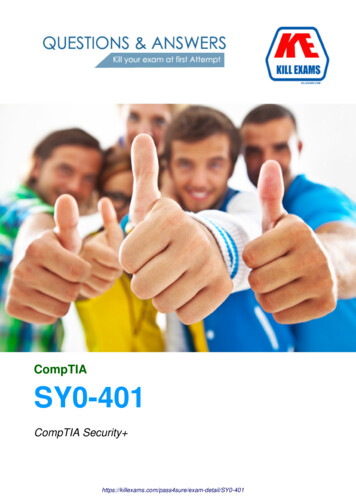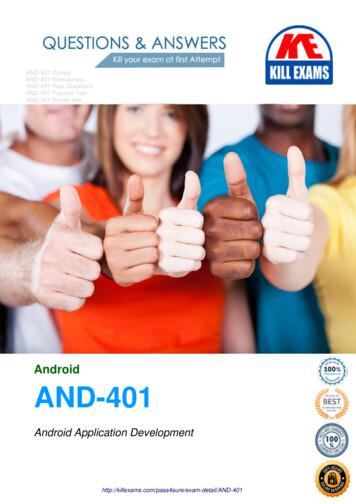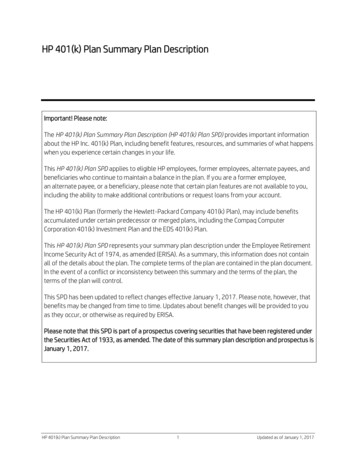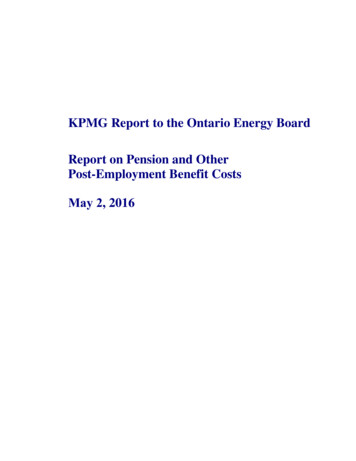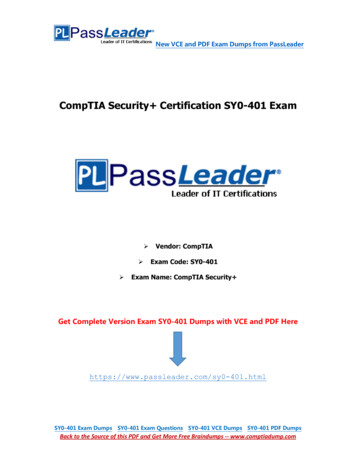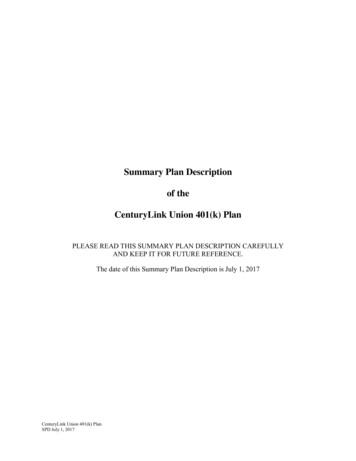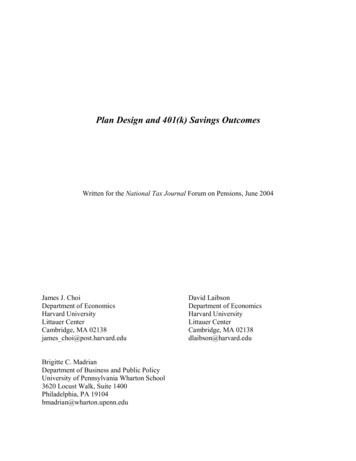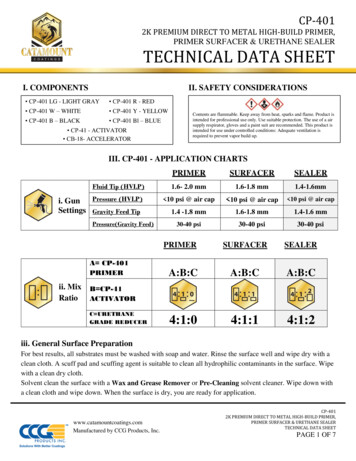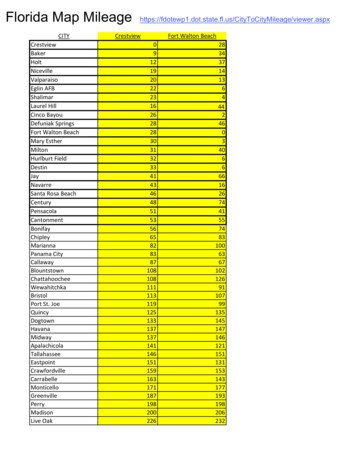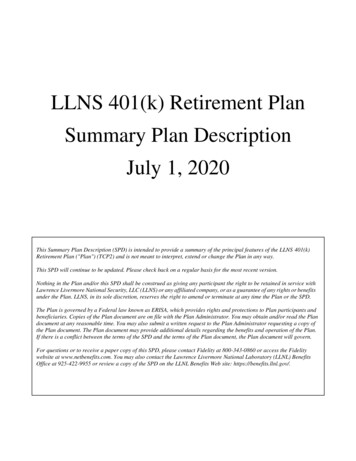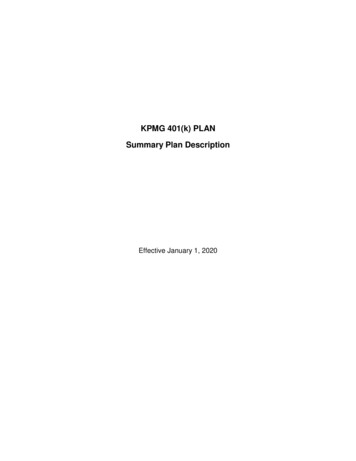
Transcription
KPMG 401(k) PLANSummary Plan DescriptionEffective January 1, 2020
TABLE OF CONTENTSPageA. INTRODUCTION . 1B. HIGHLIGHTS. 2C. ELIGIBILITY AND PARTICIPATION . 5W HO IS ELIGIBLE. 5W HEN PARTICIPATION STARTS . 5W HEN PARTICIPATION STOPS . 5PLAN FUNDING. 5D. CONTRIBUTIONS UNDER THE PLAN . 5ELECTIVE CONTRIBUTIONS . 5ROTH CONTRIBUTIONS . 6VOLUNTARY CONTRIBUTIONS. 7SPECIAL AGE 50 OR OVER CATCH-UP CONTRIBUTIONS. 7ROLLOVER CONTRIBUTIONS . 8EMPLOYER MATCHING CONTRIBUTIONS . 8MONEY PURCHASE ACCOUNTS . 9IN-PLAN ROTH CONVERSION . 9HOW YOUR ACCOUNTS GROW. 9INVESTMENT OF ACCOUNTS . 10ERISA SECTION 404(C) PLAN - LIMITATION OF LIABILITY . 10INFORMATION AVAILABLE ON REQUEST . 10TRANSACTION FEES, LIMITATIONS & RESTRICTIONS . 11ADMINISTRATIVE EXPENSES . 11INDIVIDUAL EXPENSES . 11QUARTERLY STATEMENTS . 11E. TRUST FUND . 11F. VESTING . 12G. BENEFIT UPON SEPARATION FROM SERVICE . 12IN GENERAL . 12SPECIAL RULES FOR MONEY PURCHASE ACCOUNTS . 13MAKING YOUR ELECTION. 13REQUIRED MINIMUM DISTRIBUTIONS . 13H. DEATH BENEFITS. 14IN GENERAL . 14SPECIAL RULES FOR MONEY PURCHASE ACCOUNTS . 14I. IN-SERVICE WITHDRAWALS . 15W ITHDRAWALS PRIOR TO YOUR ATTAINING AGE 59½ . 15W ITHDRAWALS AFTER ATTAINING AGE 59½ . 16J. LOANS. 16K. ROLLOVERS, TAXES AND WITHHOLDING . 18KPMG 401(k) Plan Summary Plan Description(i)Effective January 1, 2020
L. MISCELLANEOUS . 18TOTAL AND PERMANENT DISABILITY . 18TOP HEAVY RULES. 18THE PENSION BENEFIT GUARANTY CORPORATION. 19FEDERAL INCOME TAX LIMITS . 19QUALIFIED DOMESTIC RELATIONS ORDERS . 19EMPLOYMENT AT W ILL. 19IMPROPER IRS LEVY . 19M. SERVICE IN THE ARMED FORCES . 19N. PLAN AMENDMENT OR TERMINATION . 19O. CLAIMING YOUR BENEFIT . 20P. ERISA RIGHTS . 21Q. GENERAL INFORMATION . 22APPENDIX A – SPECIAL PROVISIONS FOR DISASTER RELIEF . 23APPENDIX B – SPECIAL 2020 PROVISIONS FOR COVID-19 RELIEF . 25KPMG 401(k) Plan Summary Plan Description(ii)Effective January 1, 2020
A. INTRODUCTIONThe KPMG 401(k) Plan (the “Plan”) is designed to help you provide for your financial security afterretirement. The Plan offers Employees and Partners the opportunity to save for their future on a taxdeferred basis, or by means of after-tax contributions (including Roth 401(k) contributions) with theconvenience of automatic payroll deduction. To encourage savings, KPMG matches a portion of theamount deferred each year on a pre-tax or Roth basis. Your salary deferrals, KPMG’s matchingcontributions under the Plan, any other qualified plans in which you participate, as well as your SocialSecurity benefits and your personal savings and investments, will help provide for your retirement years.The Plan became effective May 1, 1984, and has since been amended to meet current legal requirementsand for other administrative reasons. This document is a summary of the Plan – the Plan’s Summary PlanDescription (“SPD”). Except as otherwise noted, it reflects the terms of the Plan as in effect on January 1,2020. Certain terms used in this SPD are shown in bold and italicized type to indicate that those termshave special definitions.Effective as of August 31, 2004, the KPMG Money Purchase Plan was merged with and into this Plan.Each participant’s account in the Money Purchase Plan has been transferred to a separate account in theparticipant’s name under this Plan known as a “Money Purchase Account.”Effective as of December 31, 2007, the KPMG 401(k) Plan II was merged with and into this Plan, and theaccounts of any participant in the 401(k) Plan II were transferred to this Plan.****This Summary Plan Description merely summarizes the principal provisions of the Plan. It is not thePlan document. If there is any conflict between the provisions of the Plan document and thissummary, the provisions of the Plan document will be controlling.KPMG 401(k) Plan Summary Plan Description1Effective January 1, 2020
B. HIGHLIGHTSThe following chart highlights the major features of the Plan.Plan FeatureHighlightsConsiderationsEligibilityYou are eligible to participate if you area regular common-law Employee or aPartner (including a Principal) of KPMGLLP and you are not covered by acollective bargaining agreement thatdoes not provide for participation in thePlan; a nonresident alien; compensatedby retainer fee or other form ofcompensation other than salary, wagesor bonuses; classified as a leasedemployee, temporary employee, orindependent contractor; or eligible toparticipate in the KPMG Puerto RicoSavings Plan while your primary dutiesand responsibilities are performed inPuerto Rico.If you are eligible, you beginparticipating in the Plan on the 60thday following the date you are firstcredited with an hour of service,provided that you are an eligibleEmployee or Partner on that date.ElectiveContributionsYou may elect to have up to 50% of youreligible compensation withheld fromyour pay each pay period andcontributed to the Plan on a pre-taxbasis. These are known as your“elective contributions” and are held inyour Elective Contribution Account.Elective contributions and theinvestment earnings on thesecontributions are not subject toincome tax until distributed.RothContributionsYou may elect to have up to 50% of youreligible compensation withheld fromyour pay each pay period andcontributed to the Plan on an after-tax“Roth” basis. These are known as your“Roth contributions” and are held in yourRoth Contribution Account.Roth contributions are made on anafter-tax basis. Since they are taxedbefore contribution to the Plan, Rothcontributions are not taxable whendistributed. In addition, the earningson these contributions may be taxfree when distributed from the Plan ifcertain conditions (described under“Roth Contributions” on page 6) aremet.VoluntaryContributionsYou may elect to have up to 50% of youreligible compensation withheld fromyour pay each pay period andcontributed to the Plan on an after-tax(non-Roth) basis. These contributionsare known as your “voluntarycontributions” and are held in yourVoluntary Contribution Account.Voluntary contributions are taxedbefore contribution to the Plan; aftertax voluntary contributions are nottaxable when distributed. However,the earnings on these contributionsare subject to income tax whendistributed.Special Age50 Catch-upContributionsParticipants age 50 or older who makethe maximum elective contributionsand/or Roth contributions otherwiseallowed under the Plan may makeadditional elective contributions and/orRoth contributions each plan year, up tocertain limits.Catch-up contributions are held inyour Elective Contribution Accountor Roth Contribution Account, asapplicable.KPMG 401(k) Plan Summary Plan Description2Effective January 1, 2020
MatchingContributionsKPMG will make matching contributions Matching contributions are made toequal to 25% of your electiveyour Company Contributioncontributions and/or Roth contributionsAccount.(but not your voluntary contributions orcatch-up contributions). Matchingcontributions will not be made on yourbehalf to the extent electivecontributions and/or Roth contributionsexceed 5% of your compensation thatrepresents your base salary earnedwhile a participant for the plan year. Insome years, KPMG may increase therate of matching contributions. If suchincrease applies for any year, you will benotified.RolloverContributionsThe Plan will accept rollovers from otherqualified retirement programs. Youmust certify in writing that thecontribution qualifies as a rollovercontribution. These contributions areheld in your Rollover ContributionAccount.Rollover contributions are fullyvested at all times.Other AccountsIf you had an account under the KPMGMoney Purchase Plan, that account wastransferred to this Plan as of August 31,2004, and is known as your MoneyPurchase Account.These accounts are not eligible forPlan loans. In addition, specialprovisions apply to the distribution ofyour Money Purchase Account.If you made deductible voluntarycontributions to the Plan prior toJanuary 1, 1987, such contributions areheld in your Deductible VoluntaryContribution Account.DistributionsYour vested account balance generallycan be paid to you in a lump sumpayment or in the form of installmentpayments. Installment payments are tobe made monthly over a period notexceeding your life expectancy (or thejoint and last survivor expectancy of youand your beneficiary).You choose the distribution optionthat best suits your needs. If youelect a lump sum payment orinstallments for a period of fewerthan ten years, you may be able toroll over all or part of the amountreceived to another qualified plan oran individual retirement account(IRA).Payment DatesThe normal retirement date under thePlan is your 62nd birthday.You can defer payment of your Planaccount to a later date, subject tocertain federal income tax laws.WithdrawalsWhile still an Employee or Partner, youmay be able to withdraw amounts fromyour accounts under the followinglimited circumstances:Amounts withdrawn may be subjectto taxation in the year of receipt. From your Voluntary ContributionAccount and Rollover ContributionAccount at any time.KPMG 401(k) Plan Summary Plan Description3Amounts received prior to attainingage 59½ may also be subject to anearly distribution penalty tax.Effective January 1, 2020
LoansVesting From your total vested accounts(other than your Money PurchaseAccount) at age 59½. From your Elective ContributionAccount and/or Roth ContributionAccount in the event of “hardship.” From your Company ContributionAccount if you have at least fiveyears of Plan participation.Once withdrawn, unlike a loan, theamount received may not bereturned to the Plan.In general, you may borrow up to onehalf of your nonforfeitable accountbalance or 50,000, whichever is less.Loans are not available from yourMoney Purchase Account orDeductible Voluntary ContributionAccount. Other terms andrestrictions also apply.You become fully vested in yourCompany Contribution Account uponreaching the Plan’s normal retirementage (age 62), incurring a total andpermanent disability, or your death;provided, in each case, that you are anEmployee or Partner of KPMG on theoccurrence of the applicable event. Inaddition, for contributions made for planyears beginning before December 1,2002, you become 100% vested in yourCompany Contribution Account underthe Plan after five years of service. Forcontributions made for plan yearsbeginning after November 30, 2002, youbecome vested in a percentage of yourCompany Contribution Account (rangingfrom 20% to 100%), depending uponyour years of service.Vesting refers to when the right toreceive your Company ContributionAccount is no longer subject toforfeiture.You are 100% vested at all times in yourPlan accounts other than your CompanyContribution Account.Death BenefitsInvestmentsIf you die before you retire or leaveKPMG, or during an eligible leave ofabsence, your vested accounts thathave not already been paid to you arepayable to your surviving spouse orother beneficiary.If you are married, your spouse isautomatically your beneficiaryunless he or she consented to thenaming of another beneficiary.You direct the investment of youraccount balances among a group offunds designated by the PlanAdministrator. You may divide youraccounts among one or more of thevarious funds.Rules governing investments arefound in the Plan documents.KPMG 401(k) Plan Summary Plan Description4Effective January 1, 2020
C. ELIGIBILITY AND PARTICIPATIONWho is EligibleYou are eligible to participate in the Plan if you are an eligible Employee or Partner (including a Principal)of KPMG and you are not: covered by a collective bargaining agreement that does not provide for participation in the Plan; a non-resident alien; compensated by retainer fee or other form of compensation other than salary, wages, bonuses orprofit participation; classified as a leased employee, temporary employee, or independent contractor; or eligible to participate in the KPMG Puerto Rico Savings Plan while your primary duties andresponsibilities are performed in Puerto Rico.When Participation StartsIf you are an eligible Employee or Partner, you begin participating in the Plan on the 60th day followingthe date you are first credited with an hour of service, provided that you are an eligible Employee orPartner on that date. You begin participation by electing to defer a percentage of your eligiblecompensation into the Plan.When Participation StopsYou remain a participant in the Plan until you receive a distribution of your entire vested interest in youraccount balance(s). However, for purposes of your eligibility to make and receive contributions, you ceaseto be a participant on the earliest to occur of your death, separation from service, or transfer to a group ofindividuals who are ineligible to participate in the Plan.Plan FundingThe Plan is funded in part by contributions you make and partly by contributions made by KPMG to the trustfund on behalf of eligible participants.D. CONTRIBUTIONS UNDER THE PLANThere are several types of contributions that can be made to the Plan:Elective ContributionsYou may participate in the Plan by making regular 401(k) contributions known as “elective contributions.”Elective contributions are deducted from your eligible compensation (described below) before incometaxes are computed. Thus, by making elective contributions, you are reducing the amount of your earningsfor the plan year that is subject to tax. At the same time, your elective contributions and the income theyearn are tax free while they are in the Plan. (Note - Social Security taxes are based on your total earningsbefore reduction for elective contributions. Therefore, the amount of your income from Social Security atretirement will not be reduced by your elective contributions.)You may elect to make elective contributions by having up to 50% of your eligible compensation for eachpay period withheld from your paycheck and contributed to the Plan. Elective contributions can be made inlieu of, or in addition to, Roth contributions and/or voluntary contributions (described below), but together,these contributions may not exceed 50% of your eligible compensation for the pay period. In addition,elective contributions and Roth contributions together are subject to an overall annual dollar limit. This limitis 19,500 for 2020 and may be adjusted in future years for inflation.KPMG 401(k) Plan Summary Plan Description5Effective January 1, 2020
Your initial election to make contributions following your commencement of participation will be effective assoon as administratively feasible following receipt by the Plan Administrator. You may suspend or resumemaking elective contributions or change the amount of your elective contributions as of any payday uponprior notice to the Plan Administrator, in accordance with procedures established by the Plan Administrator,and such request will be effective as soon as administratively feasible after receipt by the PlanAdministrator.Once made to the Plan, elective contributions may not be recharacterized as another type of contributionunless you elect to make an in-Plan Roth conversion, as described below. Your elective contributions arefully vested at all times and are held in an account established in your name known as your “ElectiveContribution Account.”Roth ContributionsYou may designate part or all of your Plan contributions as either elective contributions (described in thepreceding section), or as after-tax “Roth” contributions. Unlike elective contributions, Roth contributions arededucted from your pay on an after-tax basis; that is, they are subject to the same withholding for taxes,and will be included in your income, on the same basis as any other compensation you receive. Just aswith elective contributions, the income on Roth contributions accumulates tax free while in the Plan. Upondistribution, however, Roth contributions and earnings are tax free if certain requirements are met.Perhaps the major advantage of making Roth contributions is that the income earned on these contributionsis not taxed at distribution from the Plan; that is, it is excluded from income entirely, provided: (i) the dateyour first Roth contribution was made to the Plan was at some time during or earlier than the fifth calendaryear before the year of distribution, and (ii) you are at least age 59½ at the time of distribution (or thedistribution is due to your death or total and permanent disability). Another advantage is that, providedthey are rolled over to a Roth IRA before the year in which the later of the following occurs (i) you attain age72 (or, age 70½, if you turned 70½ before January 1, 2020); or (ii) your retirement, Roth contributions andthe income on such contributions are not subject to minimum annual distribution requirements that apply toall other retirement plan assets starting at that time.Roth contributions can be made in lieu of, or in addition to, elective contributions and/or voluntarycontributions (described below), but, together, these contributions may not exceed 50% of your eligiblecompensation for the pay period. In addition, Roth contributions and elective contributions together aresubject to an overall annual dollar limit. This limit is 19,500 for 2020 and may be adjusted in future yearsfor inflation. Roth contributions are subject to the same rules as elective contributions with respect tomaking and changing elections and investing your account, and are available for purposes of loans andcertain in-service withdrawals.Roth contributions offer an important savings option. However, they are not for everyone. The taxes thatapply to Roth contributions will result in lower take home pay if you contribute the same amount as you hadplanned to contribute as elective contributions. And if you reduce your Roth contributions to keep your takehome pay the same, any investment earnings will be reduced because of the lower contribution. Eitherway, you are, in effect, prepaying taxes otherwise due at retirement, but there is no way to predict whetherfuture tax rates will be higher or lower than at present.KPMG 401(k) Plan Summary Plan Description6Effective January 1, 2020
Below are some general guidelines you may wish to consider when evaluating whether Roth contributionsare right for your tax situation. You are urged to consult with your tax advisor to help you evaluate yourpersonal tax situation before deciding whether to make Roth contributions.Participants Who May Benefit From Making RothContributionsParticipants Who May Not Benefit FromMaking Roth Contributions Participants who expect they will be in alower tax bracket after retirement. Participants who expect their income todrop substantially after retirement. Participants who will rely principally onSocial Security in retirement.Participants at any income level who are saving at anabove-average rate and who expect to be in the sameor a higher tax bracket at retirement, or who expectthat tax rates will be higher at retirement or when Rothcontributions will be distributed than at present. Lower and middle-income participants who are payinglow or no federal income taxes today - they receivefewer current tax benefits from pre-tax savings. Individuals who wish to delay distributions of theirretirement benefits beyond age 72 (or, age 70½, ifyou turned 70½ before January 1, 2020) by rollingthese amounts into a Roth IRA, Higher-income participants who are not eligible for aRoth IRA.If you do not designate whether your contributions to the Plan will be made as elective contributions or Rothcontributions, your contributions will automatically be treated as elective contributions. Once made to thePlan, Roth contributions may not be recharacterized as another type of contribution. Roth contributions arefully vested at all times, and are held in a separate account established in your name known as your “RothContribution Account.”Voluntary ContributionsIn addition to elective contributions and Roth contributions, you may make after-tax, non-Roth contributionsknown as “voluntary contributions.” Voluntary contributions are deducted from your eligible compensationafter income taxes and Social Security tax are computed. The income on voluntary contributions is tax freeuntil it is distributed from the Plan.Voluntary contributions can be made in lieu of, or in addition to, elective contributions and/or Rothcontributions, but, together, these contributions may not exceed 50% of your eligible compensation for thepay period. Voluntary contributions are subject to the same rules as elective contributions with respect tomaking and changing elections and investing your account, and are available for in-service withdrawals andloans. Once made to the Plan, voluntary contributions may not be recharacterized as another type ofcontribution, unless you elect to make an in-Plan Roth conversion, as described below. Voluntarycontributions are fully vested at all times and are held in an account established in your name known asyour “Voluntary Contribution Account.”Special Age 50 or Over Catch-up ContributionsIn addition to the elective contributions and/or Roth contributions described above, participants who will beat least 50 years old by the end of the calendar year and who will have contributed the maximum amount ofelective contributions and/or Roth contributions for the year (or are otherwise limited in the amount ofelective contributions and/or Roth contributions that may be made to the Plan) may designate up to 20% oftheir eligible compensation each pay period as Plan “catch-up contributions.” Catch-up contributions arelimited to 6,500 for 2020 (as indexed for inflation) for the plan year.Catch-up contributions may be made on a pre-tax or Roth basis, as you elect. If you make no suchelection, your catch-up contributions will be treated as having been made on a pre-tax basis. Your electionto make, suspend or modify your catch-up contributions may be made as described under ElectiveContributions above. Any catch-up contributions you make will be held in your Elective ContributionAccount or Roth Contribution Account, as applicable.KPMG 401(k) Plan Summary Plan Description7Effective January 1, 2020
Rollover ContributionsAt the discretion of the Plan Administrator, you may “roll over” to the Plan distributions you receive fromother qualified plans. You must submit written certification from the prior plan that the contribution qualifiesas an eligible rollover contribution. The Plan Administrator may rely upon this certification.A former Employee or Partner who has an account under the Plan the value of which exceeds 5,000 mayroll over to the Plan a distribution from an eligible retirement plan sponsored by KPMG, to the extent thatthe distribution satisfies the requirements for an eligible rollover contribution under IRS rules.Any rollover contribution you make is fully vested at all times and is allocated to a “Rollover ContributionAccount” maintained on your behalf.Employer Matching ContributionsKPMG will make a matching contribution to the Plan for each plan year equal to 25% of your electivecontributions and/or Roth contributions for the plan year; provided, however, that matching contributionsyou receive for the plan year will not be made with respect to any of your elective contributions and/or Rothcontributions that exceed 5% of your compensation (subject to the statutory limit described on page 10) thatrepresents your base salary earned (or the equivalent for any Partner) for the plan year while a participant.In some years, KPMG may increase the rate of matching contributions. If such increase applies for anyyear, you will be notified.Please keep in mind that KPMG reserves the right to change the matching contribution at any time. Pleasealso note that matching contributions will not be made with respect to your catch-up contributionsor voluntary contributions.Examples:Pat’s eligible compensation (defined on page 10) for the plan year is 65,000. Pat’s eligiblecompensation consists of base salary of 60,000, and combined annual incentive bonus and overtime payof 5,000. The charts below show how Pat’s elective contributions and matching contributions aredetermined at a 25% matching contribution rate.25% Matching Contribution RateAssume Pat elects to make an annual elective contribution to the Plan of 5% of eligible compensation.Annual elective contribution (eligible compensation x 5%): 65,000 x 5% 3,250Portion of annual elective contribution eligible for match (5%x base salary ):5% x 60,000 3,00025% matching contribution on eligible elective co
The Plan became effective May 1, 1984, and has since been amended to meet current legal requirements and for other administrative reasons. This document is a summary of the Plan - the Plan's Summary Plan Description ("SPD"). Except as otherwise noted, it reflects the terms of the Plan as in effect on January 1, 2020.
